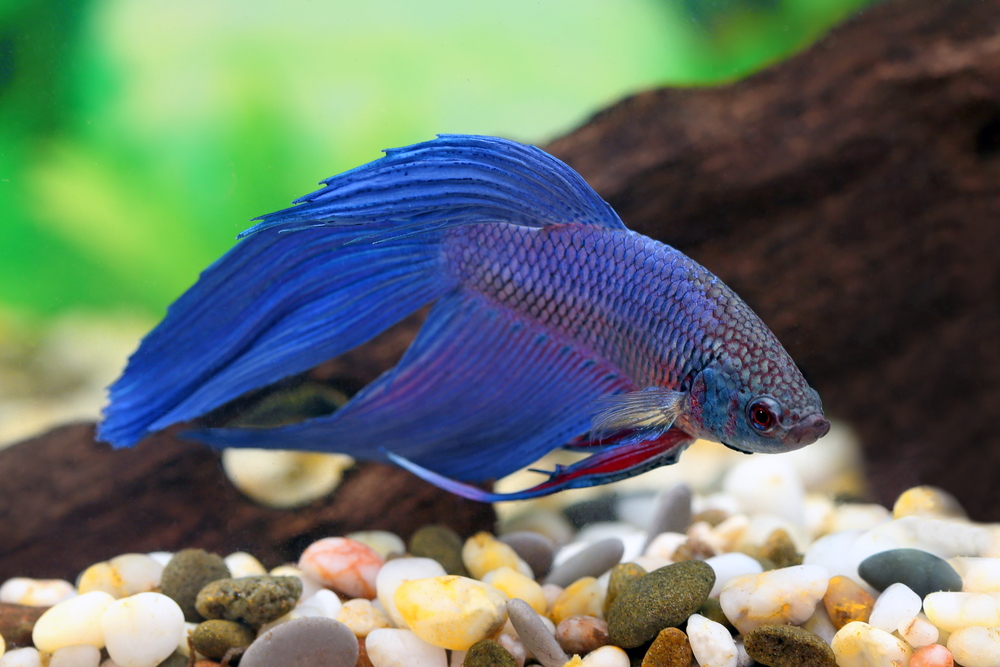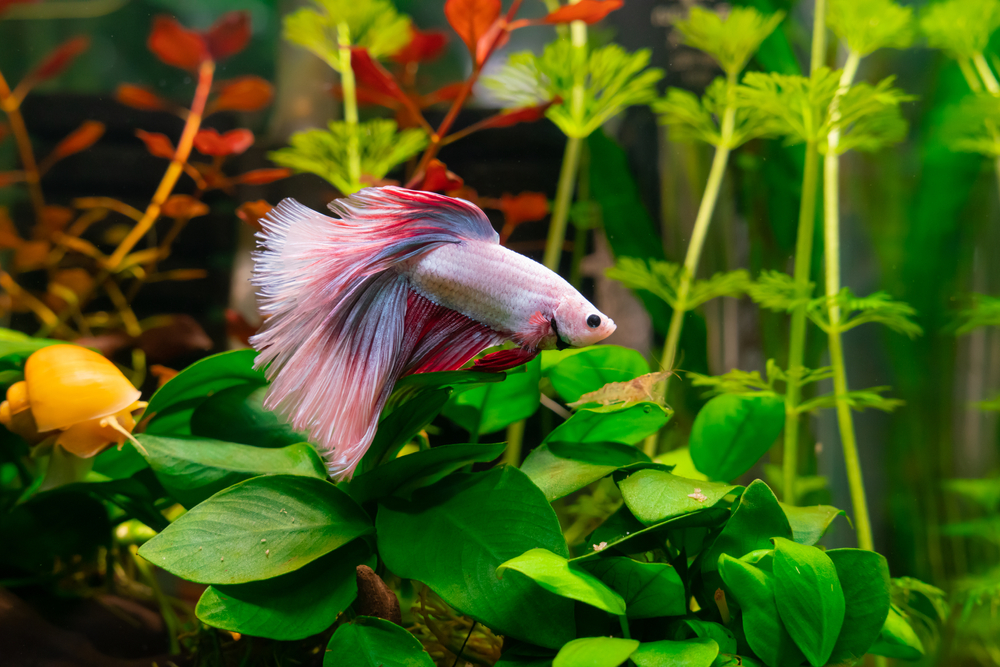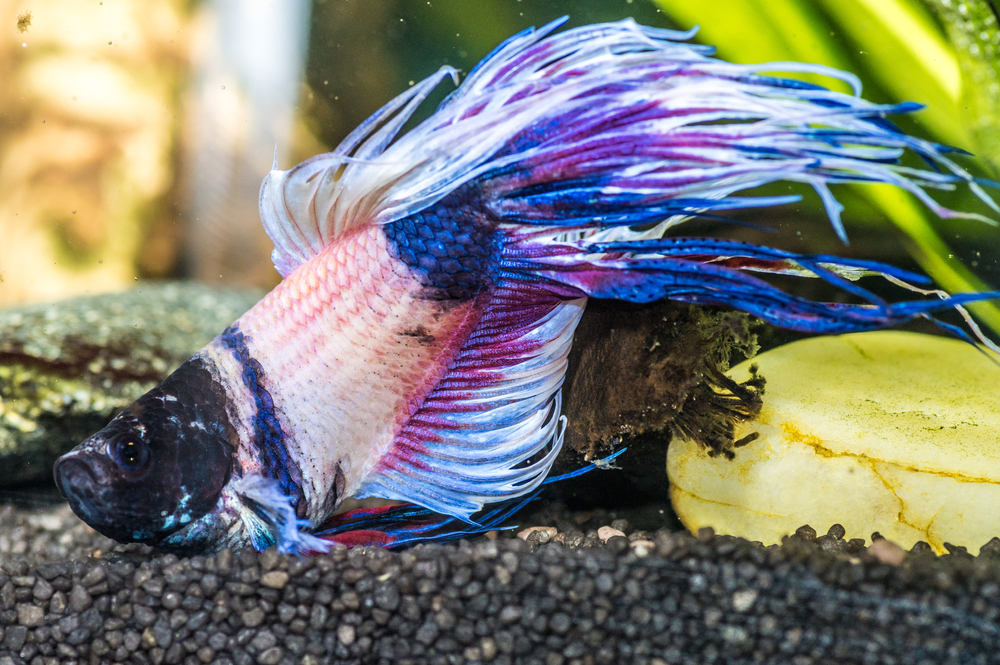Among the many fascinating behaviors of Betta splendens, gill flaring is the most iconic. When bettas flare, they appear bigger and more intimidating, even to aquarists. You’ve probably noticed your betta doing this and wondered why.

The good news is that this display is normal for bettas; the less desirable news is that that display often means trouble. Thus, learning why bettas flare and how to react if needed is important. So, read on as we discuss this exciting betta behavior and how to navigate it.
Contents
Understanding Betta Fish Behavior
Betta splendens is also called the Siamese fighting fish due to its aggressive tendency. This aggressiveness has evolved alongside the species’ territorial instincts, causing members to mark and sternly defend their territory. However, all bettas are not equally aggressive; males are more territorial than females and, thus, more prone to aggressive displays.
When a betta sees another fish in its territory, it flares up to intimidate and warn them. This display involves the betta extending its gills and fins, thus appearing bigger. However, bettas don’t only flare to deter territorial intruders; flaring serves the following other purposes:
- Mating Displays: Betta fish sexual selection favors vibrant, dominant, and intimidating males. So, male bettas flaring up display their vigor and dominance when courting females. If the female is impressed, the mating ritual may commence.
- Stress Response: Sometimes, your betta may seem to flare up randomly and uncaused, but such seemingly random flareups are due to stress. For example, your betta may notice its reflection in the aquarium glass, mistake that image for a rival or intruder, and flare up to warn it off. Alternatively, the betta may react to uncomfortable temperature spikes, excessive water currents, or some other source of discomfort. Sometimes, the betta may flare at you!
- Protecting spawns: A male betta protects its spawns as fiercely as its territory. In the wild habitat, the male must warn off many potential predators, Sometimes including other male bettas, since cannibalism occurs in the species. However, in an aquarium, a male bettas flaring up to protect spawn often does so against the female who laid the eggs since he now deems her presence a territorial challenge.
Get to understand more about your betta friend from these other top posts:
Why Do Betta Fish Flare Their Gills?
Whether you’re a fish geek or just a passionate aquarist, it’s essential to understand the anatomy involved in betta flaring. Sometimes, your betta may not appear to flare properly or fully, indicating injury or ill health.
Knowing the relevant anatomy can help you notice and treat any such injury accordingly. So, let’s talk about betta gills, specifically the key features like the gills, gill flaps, and operculum.
Physical Structure of Gills

The gills are delicate, branching structures on the side of the betta’s head. These structures have many small blood vessels called capillaries and are useful for extracting oxygen from the water. Interestingly, bettas don’t rely entirely on these gills.
The species also has a unique labyrinth organ used to breathe surface air in low-oxygen, shallow water environments. But back to the gills, bettas use those taking in water orally and passing it over their gills to absorb the oxygen.
Since gills are so fragile, they’ll be behind the operculum, a protective barrier that hides the males’ “beards.” The operculum opens and closes to control water intake at the gills, and it may open up when the betta flares.
Physical Structure of the Fins
Bettas also flare their fins when provoked. The species has four types of fins, namely the ventral, dorsal, anal, and pectoral fins. Some of these fins are much smaller in females than in males. Furthermore, the fin sizes and shapes vary across betta breeds.
However, all these fins help a betta stabilize itself and navigate in the water, and they spread out in flaring displays
Management and Prevention of Excessive Flaring
If your betta flares too frequently, you need to identify the source of its persistent discomfort. However, it’s always better to maintain a comfortable and stress-free environment, so your betta isn’t unhappy so often. You must provide adequate tank space, water quality maintenance, and habitat enrichment to achieve this.
Tank Decor
Bettas can get claustrophobic, so ensure their aquarium is large enough. The optimum size is 5 to 10 gallons, although you could always go for a bigger aquarium, especially if you want your betta to have a few tank mates.
Water Quality

The water conditions in your spacious tank should be conducive to betta survival. This means that the water must be clean, preferably deionized. If you use tap or distilled water, add deionized water to reintroduce essential minerals like calcium, potassium, magnesium, and sodium.
You must also maintain other parameters like pH, temperature, and pollutant concentrations. For instance, the ideal water temperature range is between 78 and 80 degrees Fahrenheit, the ideal pH is between 6.5 and 7.0, and the ideal concentration for pollutants like nitrate and ammonia should be zero.
Monitoring and regulating these water quality factors requires heaters, thermometers, and water testing kits. You’ll need to use these regularly and perform periodic water changes when the relevant concentrations get out of hand.
Habitat Decor and Enrichment
You want to reduce stress further by keeping the tank’s decor and layout simple yet enriching, avoiding excessively vibrant colors that might simulate another betta’s presence. Subdued color schemes make bettas feel secure.
Additionally, you might leverage other pieces of decor, such as driftwood as a centerpiece, plants to provide greenery, and some smooth rocks and caveworks as hiding places.
Health and Medicine

Illness or disease can also cause excessive flaring. As such, you need to keep the habitat healthy by cleaning it regularly. This will prevent illnesses due to weakened immune systems and reduce the need to see the vet.
However, you must also watch your betta closely and treat it as soon as you notice any sign of sickness. Aquarium salt treatment can treat some diseases, and you can always keep some recommended drugs. Still, visiting the vet is often best.
Essentially, here are the main factors for keeping your betta comfortable:
- Sufficient space: Ensure my betta has plenty of room.
- Separate tank: If I have more than one betta, I house them separately.
- Monitor water quality: Keep the water clean and within proper parameters.
- Minimize reflection: Decorate in a way that minimizes their reflection.
- Tank enrichment: Provide plants and hiding spaces for a sense of security.
Conclusion
Bettas flare for several reasons, and as a betta aquarist, it behooves you to understand this display and what it means each time. The flaring can indicate anything from a discontent with the habitat to the presence of a territorial intruder, such as an overreaching tankmate or a female betta after mating.
No matter the case, once you identify the cause of the flaring, you can determine how best to respond.
Frequently Asked Questions
To further enlighten you on betta flaring and adequate responses, here are answers to popular questions people ask.
Why do male bettas flare their gills at females?
Male bettas flare their gills at females primarily as a mating display. It’s their way of showcasing strength and vitality to potential mates, signaling their suitability for reproduction.
However, once the mating process is over, the male becomes so protective of the spawned eggs that he may flare at the female. At that point, you must transfer her to another tank.
What causes betta fish to flare at their reflection?
Flaring at their reflection results from bettas’ natural territorial instincts. Bettas perceive their reflection as a rival invading their space and will flare to intimidate what they believe to be a competitor.
How does a water change affect betta fish gill flaring?
A sudden water change can cause betta fish to flare their gills because they may perceive the change as a threat.
Is gill flaring a sign of aggression in betta fish?
Yes, gill flaring in betta fish can be a sign of aggression. Flaring is used to intimidate rivals and establish dominance within their territory.
Can betta fish flare their gills due to happiness?
Betta fish do not typically flare their gills out of happiness. Generally, gill flaring is associated with stress or a display of aggression, not positive emotions.
What does it indicate when a betta is flaring its gills frequently?
Frequent gill flaring might indicate that a betta fish feels constantly threatened or stressed. It’s important to ensure the fish’s environment is safe and stress-free to avoid excessive flaring,

Ian Sterling, founder of Fishlab.com, began his aquarium journey over 30 years ago, driven by a deep fascination for fish and their diverse personalities. His website, Fishlab.com, is dedicated to making fishkeeping accessible and enjoyable, offering beginner-friendly guidance, expert insights, and a community for aquarists to connect and share experiences.


